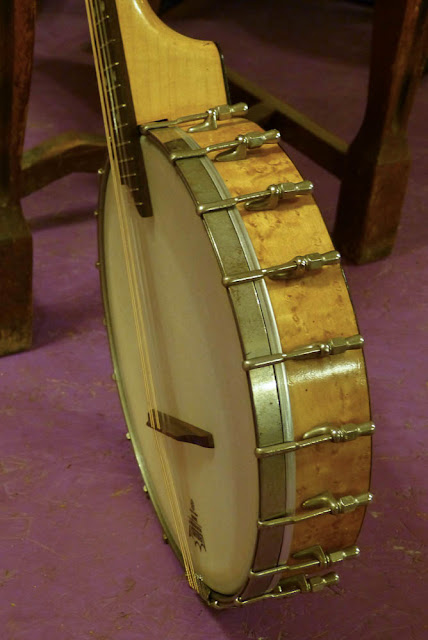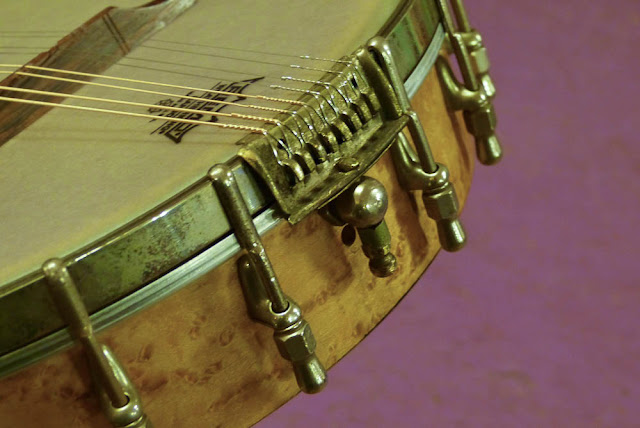c.1930 Slingerland Banjo Mandolin
This instrument came by way of a repair customer of mine. It was in pretty good shape when it arrived but I could tell it needed further setup: it got a fret level/dress, new rosewood bridge, new Renaissance (Remo) synthetic head, and a good going-through as far as setup goes. It now plays nicely with 1/16" (spot on) action at the 12th fret and has a balanced, chimey tone with plenty of volume.
It's branded Slingerland on the dowel stick but I'm pretty sure that most of the lower to mid-range Slingerland banjos were made by Regal (including this one) in Chicago.
Setup is everything with banjo mandolins because if you're not in the know about what you're doing you can often wind up with a screechy, brash, and obnoxious "rocks in a tin can" tone out of an instrument like this rather than a musical sound. The most important bit in setup is to use lighter-gauge strings (I use the GHS A240 32w-9 sets) and couple that with a slightly muted head (the fretboard extension rests lightly on the head on this guy which mutes the overtones).
For instruments with tonerings (like this one), especially, one can further mute extra (obnoxious) overtone ring and also help stabilize the tuning by using a wider, heavier, and denser mandolin-style bridge rather than the typical banjo-style lightweight maple jobs.
There's a pearl star inlaid in the headstock and pearl dots down the board. The tuners are Waverly units with ivoroid buttons (nicer than average).
The scale length on this fellow is a Gibson-style 13 7/8" which makes this neck more familiar to modern fingers. The fretboard appears to be some sort of dyed hardwood.
The rosewood bridge is also compensated.
The rim hardware is all original and "all there" with the exception of the tailpiece cover which is long gone. The rim itself is a multi-laminate maple build with birdseye maple veneer on the exterior, finished in natural color that's yellowed with age.
This guy has a 10 7/8" diameter, too, and a simple "hoop style" steel tonering.
Nice-looking tuners, huh?
The neck is two-piece hard maple with a center strip of some sort of ebonized hardwood. The neck profile is a medium U shape and quite sturdy (no warp).
Note the extra hole below the tailpiece hanger! Someone in the past of this instrument decided to just redrill a new hole for the endbolt and dowel rather than reset the dowel at a better angle. This isn't an issue as the dowel is sturdily-glued as-is.














Comments